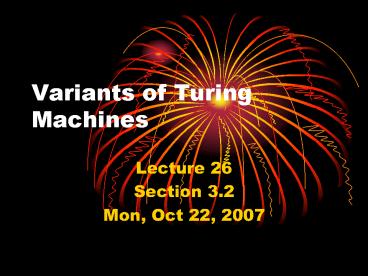Variants of Turing Machines - PowerPoint PPT Presentation
1 / 23
Title:
Variants of Turing Machines
Description:
Move the location of the current symbol one space left or right for each 'tape. ... If not, then continue in the same manner. Nondeterminism ... – PowerPoint PPT presentation
Number of Views:416
Avg rating:3.0/5.0
Title: Variants of Turing Machines
1
Variants of Turing Machines
- Lecture 26
- Section 3.2
- Mon, Oct 22, 2007
2
Increasing the Power of a Turing Machine
- It is hard to believe that something as simple as
a Turing machine could be powerful enough for
complicated problems.
3
Increasing the Power of a Turing Machine
- We can imagine a number of improvements.
- Multiple tapes
- Two-way infinite tape
- Two-dimensional tape
- Addressable memory
- Nondeterminism
- etc.
4
Multiple Tapes
- Would a Turing machine with k tapes, k gt 1, be
more powerful than a standard Turing machine? - Each tape could be processed independently of the
others.
5
Multiple Tapes
- In other words, each transition would read each
tape, write to each tape, and move left or right
independently on each tape.
6
Multiple Tapes
- Theorem Any language that is accepted by a
multitape Turing machine is also accepted by a
standard Turing machine.
7
Multiple Tapes
- Sketch of the proof
- On a single tape, we could write the contents of
all k tapes. - If tape i contains xi1xi2xi3, for each i, then
write - x11x21xk1x12x22xk2...
- on the single tape.
8
Multiple Tapes
- To show the current location on each tape, put a
special mark on one of that tapes symbols - x11x21xk1x12x22xk2...
- Now the Turing machine scans the tape, locating
the current symbol on each tape.
9
Multiple Tapes
- It then makes the appropriate transition.
- Write a symbol over each of the current symbols.
- Move the location of the current symbol one space
left or right for each tape. - Of course, the devil is in the details.
10
Two-way Infinite Tape
- We can use a two-tape machine to simiulate the
two-way infinite tape. - The right half of the two-way tape is stored on
tape 1. - The left half is stored on tape 2.
- Transitions are modified to handle the transition
from tape 1 to tape 2.
11
Two-way Infinite Tape
- Theorem Any language accepted by a two-way
infinite tape is also accepted by a standard
Turing machine.
12
Other Variants
- Metatheorem Any language accepted by a Turing
machine with any variant that anyone has ever
thought of is also accepted by a standard Turing
machine.
13
Nondeterminism
- A nondeterministic Turing machine is defined like
a standard Turing machine except for the
transition function. - ? Q? ? ? ? ?(Q ? ? ? L, R)
- where Q? Q qacc, qrej.
14
Nondeterminism
- That is, ?(q, a) may result in any of a number of
actions. - If any sequence of transitions leads to the
accept state, then the input is accepted. - If all sequences of transitions lead to the
reject state or to looping, then the input is not
accepted.
15
Nondeterminism
- Theorem Any language accepted by a
nondeterministic Turing machine is also accepted
by a standard Turing machine.
16
Nondeterminism
- Proof
- We may use a three-tape machine to simulate a
nondeterministic Turing machine. - Tape 1 preserves a copy of the original input.
- Tape 2 contains a working copy of the input.
- Tape 3 keeps track of the current state in the
nondeterministic machine.
17
Nondeterminism
- Start with the input w on Tape 1 and with Tapes 2
and 3 empty. - Copy w from Tape 1 to Tape 2.
- For Tape 3, imagine the transitions starting from
the start state as forming a tree. - Each state has child states.
18
Nondeterminism
- Let b be the largest number of children of any
node. - Number the children of each state using the
numbers 1, 2, , b (as many as needed).
19
Nondeterminism
- Now each finite string of numbers from 1, 2, ,
b represents a particular path through the
nondeterministic Turing machine, or else
represents no path at all. - Beginning by writing the empty string on Tape 3,
representing no moves at all.
20
Nondeterminism
- If that leads to acceptance, then quit.
- If not, then replace ? with its lexicographical
successor. - For that string, follow the sequence of
transitions that it describes.
21
Nondeterminism
- If that sequence leads to acceptance, then quit
and accept. - If not, then continue in the same manner.
22
Nondeterminism
- If w is accepted by the nondeterministic Turing
machine, then some sequence of transitions leads
to the accept state. - Eventually that sequence will be written on Tape
3 and tried.
23
Nondeterminism
- On the other hand, if no sequence of transitions
leads to the accept state, then the deterministic
Turing machine will loop.































